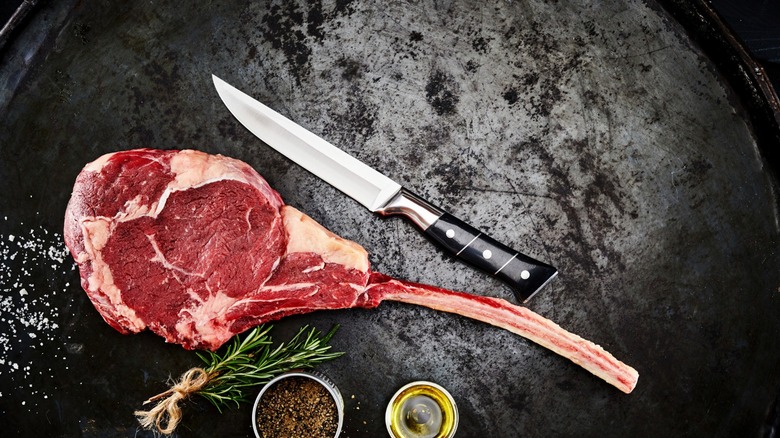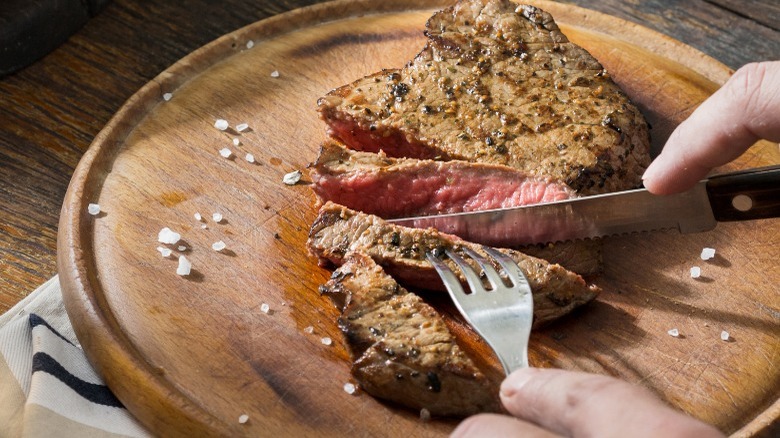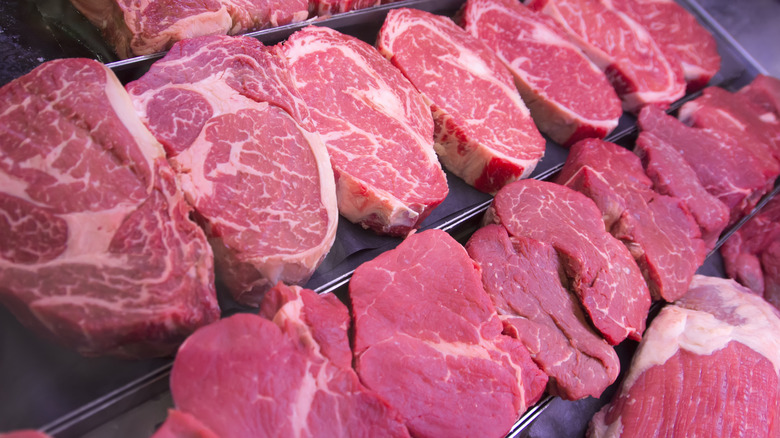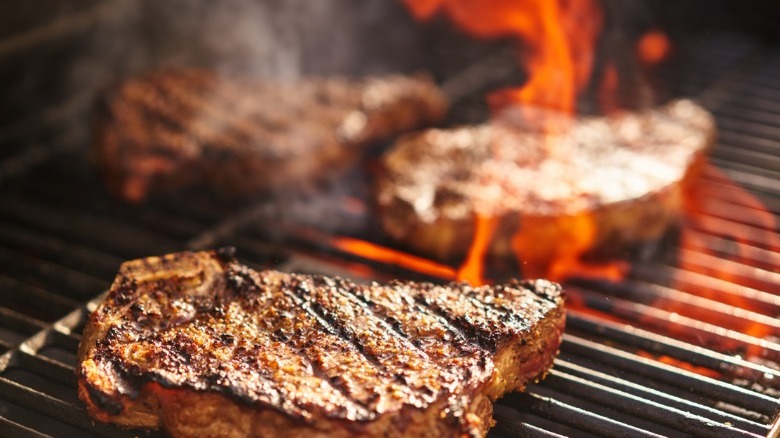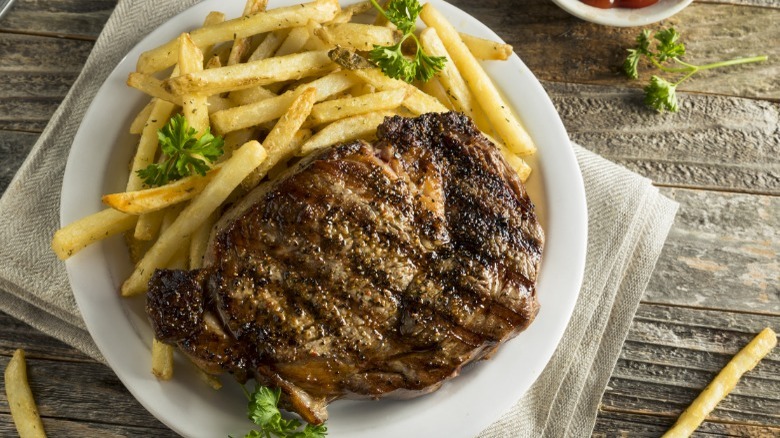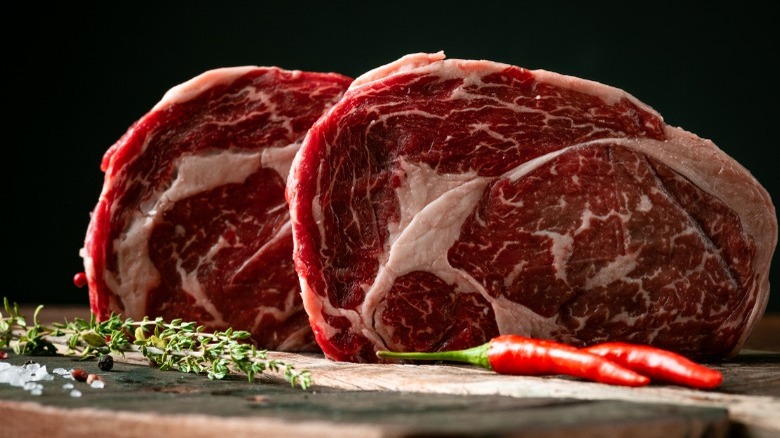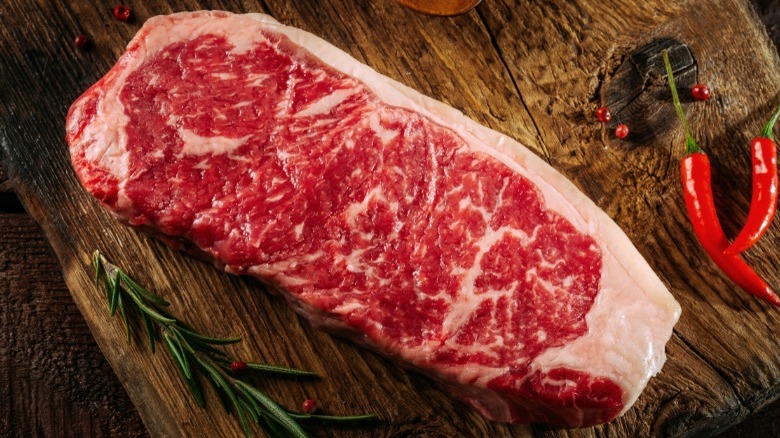What Exactly Is A 'Delmonico' Steak?
You may have seen packaged Delmonico steaks in your grocery store's meat department or on steakhouse menus and breezed by them with nary a thought. But this specialty steak is worth more attention than that and could become a new favorite. It's not as common as filet mignon or New York strip, and like the latter, Delmonico isn't named after a part of a cow.
With Delmonico steaks, the size and quality are prioritized rather than the specific cut. This means that there are many different versions, so it isn't easy to find an exact definition. They're carnivore-friendly slabs of meat that are on the thicker side and heavily marbled with fat. Delmonico steaks are also called boneless ribeye, chuck eye steaks, and chuck filet steaks. Most often they're made with rib steaks since these are one of the most sought-after cuts. Delmonico steaks can be dry- or wet-aged but are usually the latter, which is the most traditional. And to complicate matters even further, they can be bone-in or boneless.
Confused? There's no simple answer to what defines a Delmonico steak, but as you learn more about them, you'll be able to recognize the differences. Fans call themselves Delmonicos, and once you try one of these thick, juicy steaks, you'll never go back. Here's everything else you need to know about Delmonico steaks, from the history to today's pricing information.
Why is it called Delmonico steak?
So it's not named after a cow part and not named after a state ... what does "Delmonico" mean? The name refers to a famous New York City restaurant, opened in 1827, that was the first in the U.S. to have a menu for patrons to order from. This landmark was the go-to spot for fine dining starting in the mid-19th century. In addition to Delmonico steak, the original Delmonico's is also credited for inventing other legendary dishes like eggs Benedict, baked Alaska, and lobster Newberg.
Over time, the Delmonico family opened up several other namesake restaurants, and the original one shuttered its doors in 1923. Although the owners protested, in subsequent years, other restaurants with similar names started popping up in different locations in the U.S. Since the name "Delmonico" is closely associated with quality steak, many of these eateries have been able to capitalize on that.
What does Delmonico steak taste like?
Since Delmonico steak comes in so many different forms, there isn't a single taste profile that can describe all of the varieties. In general, it has an intensely beefy taste with significant juiciness that comes from marbled fat. Anyone who doesn't appreciate the taste of fat might not be as drawn to these statement steaks and may prefer leaner cuts like sirloin. Others can dig into bite-sized pieces of Delmonico that contain thick fat and meat, or trim off some of the excess fat. But remember, that fat is what gives the Delmonico its flavor.
Just remember to read the menu or label description to see what part of the cow the Delmonico was sourced from. A ribeye will taste quite different from a chuck filet. This is not a delicate piece of meat by any means, yet all the cuts can be exceptionally tender when properly prepared.
Where to buy Delmonico steak
Many restaurants carry at least some part of the Delmonico name, and you can be confident that this steak will be highlighted on these menus. For example, DelMonico Restaurant in New Jersey has a 16- or 22-ounce Delmonico ribeye, and the chain restaurant Delmonico's Italian Steakhouse features a 24-ounce center-cut Delmonico ribeye that's served with penne at its Orlando location.
These steaks are not that hard to find, though you might not see them hanging out with the sirloin and ribeyes in your favorite meat department. Your local grocery or specialty food store might have Delmonico steak at any given time – kosher butchers may also sell these cuts of steak. Online outlets like Char Market sell trimmed, vacuum-packed Delmonico steak, but you'll pay extra for shipping. But to ensure that you're getting what you want, the best source is a local butcher. They can tell you what cut the meat is and trim it to your specifications.
How to cook Delmonico steak
Like any fine steak, Delmonicos should not be coated in ketchup, ground into burgers, or sliced up and stir-fried. The tried-and-true method is to brush the meat with melted butter or a bit of beef fat before or while it's cooking. Don't play around with spices either, since all a good Delmonico needs is a bit of salt and pepper.
Delmonico steaks can be grilled, broiled, or pan-fried. For the best results, season the steak and allow it to come to room temperature before cooking. If you're grilling your steak, clean the grates while they're still cold. Only flip the steak once, and check for readiness with a meat thermometer: No matter how you cook it, the internal temperature should reach 145 degrees Fahrenheit, according to FoodSafety.gov. To pan-fry, use a heavy-bottomed skillet and drain the fat after the meat is cooked through. Broiling Delmonico steak is also easy — place it 2 to 4 inches beneath the oven's broiler, leave the door cracked open, and flip the meat once during cooking.
Whichever method you prefer, let the meat rest for three to five minutes once it's removed from the heat. This allows the juice to reabsorb back into the meat instead of leaking out all over the plate when it's cut. And speaking of cutting, always slice your steaks against the grain to prevent it from shredding.
How should Delmonico steak be served?
There's not much to do here — Delmonico steak can be cooked rare to well done, but when it spends too much time on the fire, it'll dry out like any other steak. For those who like rare steaks with cool, red centers, the internal temperature for that is 125 degrees Fahrenheit. Remember, though, that food safety guidelines recommend at last 145 degrees, which equals medium, with a warm, pink center. To achieve the right doneness, the Delmonico can be removed from the heat a few minutes beforehand since it continues cooking during its resting time.
What goes best with Delmonico steak? One of the best accompaniments is Delmonico potatoes, which are heavy enough to balance the thick meat. This side dish is made with white potatoes, milk, cream, and Parmesan cheese. The potatoes can be chunked, mashed, or grated and get mixed in and baked with all that other good stuff. But if you don't want this kind of casserole, your steak will be just fine with plain baked potatoes or crispy french fries. Fresh vegetables like broccoli, spinach, carrots, or asparagus will also add texture and color without stealing the show. If you're planning an entire meal, we suggest starting with a homemade Caesar salad, serving a full-bodied Cabernet, and finishing with a slice of cheesecake. Hey, that's how the best steakhouses do it.
Delmonico steak vs. ribeye
Comparing Delmonico to a lovely ribeye steak isn't easy, since the two can overlap. A ribeye Delmonico will be larger than a regular ribeye and may have even more lines of marbled fat running through it. This is why so many carnivores describe the taste as buttery. Ribeyes in general are sourced from the sixth to 12th rib of the cow and are considered to be the tenderest, juiciest cut because there's so much fat in the muscle fibers. Ribeyes also tend to be thinner than some other steaks but can be about 1½ inches thick.
When a Delmonico is a chuck steak, it may be tougher since that's the shoulder region of the cow. Some describe the taste of Delmonico chuck steak as being rustic and hearty, with a more intense beef flavor. It might have less fat than a ribeye and will be less expensive per pound. If you're wondering about the nutrition data, a 100-gram serving of ribeye contains 21.8 grams of fat and 23.7 grams of protein per serving. The same portion of chuck has 6.8 grams of fat and 32 grams of protein.
Delmonico steak vs. New York strip
There's slightly less confusion here since you won't usually see a Delmonico New York strip steak. Instead of coming from the shoulder or ribs, strip steaks come from the short loin, which is behind the ribs and closer to the rear end of the cow. It's also called Kansas City strip, shell steak, and loin steak and can be boneless or bone-in.
A New York strip steak won't be as tender as a ribeye or filet mignon, but this is what so many meat lovers go for. It has a tighter texture with a satisfying chew but is still juicy because these steaks also have considerable marbling. It won't be as tough as chuck steak, though. Strip steaks can be somewhat smaller, ranging from 10 to 16 ounces and averaging about 1½ to 2 inches thick. A 100-gram serving contains 10.6 grams of fat and 27.1 grams of protein. And like Delmonicos and ribeyes, strip steaks should be the focus of any entrée that they star in, without heavy sauces and anything else that will mask their delicious, juicy flavors.
How much does Delmonico steak cost?
The answer to this depends on the cut of steak, if it's organic, and the outlet or eatery. Ordering it at restaurants is usually the most expensive option. At DelMonico Restaurant in New Jersey, you can order the 16-ounce Delmonico ribeye for $30 or the 22-ounce for $38, and Delmonico's Italian Steakhouse's 24-ounce version is listed for $37.99.
Online, you can order 14-ounce choice-cut Delmonico ribeyes from Char Market for $34.99 apiece; Seven Sons retails a 12-ounce boneless ribeye Delmonico for $25.75. These are high-end options, and you can find lower prices at area butchers. Do some research, and you should be able to find Delmonico steaks at less than $25 per pound. If you aren't having luck locating any, ask the meat department manager at your favorite grocery store. It's worth asking about if you want to try a steak that'll take your taste buds to the stratosphere.
